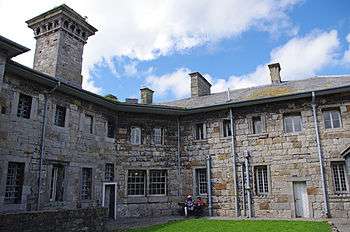Prisons in Wales

The prisons in Wales are run by Her Majesty's Prison Service, which is in turn a part of the National Offender Management Service which is an executive agency of the Ministry of Justice responsible for the correctional services in England and Wales. The objectives of prison confinement in Wales is threefold: to "hold prisoners securely", to "reduce the risk of prisoners re-offending" and to "provide safe and well-ordered establishments in which we treat prisoners humanely, decently and lawfully".[1]
Although the concept of incarceration as a punishment for wrongdoing did not exist in Wales, as in the rest of Britain, during the medieval period, from Tudor times onwards correction houses began appearing throughout the country. In the 18th century several buildings began taking on the function of modern prisons, and in 1878 Welsh prisons came under centralised government control. Today there are four prisons in Wales; three are run directly by the government with Parc Prison in Bridgend being Wales' only privatised jail.
History of prisons in Wales
The concept of incarcerating individuals as a punishment for crimes did not exist in Wales before or during the medieval period.[2] The early castles of the Welsh rulers and marcher-lords did possess dungeons, but the purpose of these facilities were for the confinement of hostages and political prisoners, people who may have committed no crime. Up to the 17th century the most common punishments for criminal offences were fines, corporal punishment and executions.[2] The earliest forms of prisons, which began appearing in the early modern period, were created for the purposes of holding those awaiting trial and to house debtors.[2] From the Tudor period magistrates were given powers by the state to establish correction houses for the punishment of those committing petty crimes and a way to amend the ways of vagrants.
From the 18th century the institutions that would begin to have the function of modern prisons began to appear in Aberystwyth, Bangor and Beaumaris.[2] These buildings were used to house criminals for a set period of time after being sentenced by a court. The condition of early prisons in Wales was rudimentary and with few amenities for the imprisoned. In his 1777 work State of the Prisons prison reformer John Howard mentions two Welsh jails, Caernarfon county jail and Swansea town jail. Caernarfon is described as having neither drainage or fresh water and the inmates housed in tiny windowless cells.[2][3]
Prisons in Wales were often of very poor build, many of which were not built for the purpose of housing prisoners, and were often the sites of existing buildings. Haverfordwest prison was originally built in the inner ward of a ruined castle in 1778.[3] It was considered unfit for prisoners in 1819, while Cardiff Gaol was deemed insufficient in 1814. Some prisons were built for purpose, including Beaumaris Gaol (1829) in Anglesey.[4]
In 1878 the prison system in Wales was nationalised and came under centralised government control.[3] This led to better conditions and fewer, larger prisons.[3] The smaller prisons and jails across the country were closed and the location of the prisons centralised.
Current prisons in Wales
There are five prisons in Wales,
- Usk (1844) a Category C men's prison which also includes a satellite site
- Prescoed (1939) a Category D men's open prison;
- Cardiff (1832) a Category B men's prison,
- Parc (1997) a Category B men's private prison and Young Offenders Institution, based in Bridgend, is Wales' only privatised prison and is presently run by G4S,
- Swansea (1861) a Category B/C men's prison.
- Berwyn (2017) a Category C men's prison, located in Wrexham is the UK's largest prison with a capacity of 2,106.
Wales has no prison for either women offenders or high risk offenders, who must be housed in jails in England.[3][5][6][7]
Notes
- ↑ HM Prison Service. "Statement of Purpose". hmprisonservice.gov.uk. Retrieved 30 December 2010.
- 1 2 3 4 5 Davies (2008), p. 713
- 1 2 3 4 5 Davies (2008), p. 714
- ↑ "The entrance to Beaumaris Gaol". Gathering the Jewels. Retrieved 30 December 2010.
- ↑ "Prison plans for women inmates". BBC News. 21 September 2000. Retrieved 30 December 2010.
- ↑ HM Prison Service (21 September 2000). "Female Prisoners". hmprisonservice.gov.uk. Retrieved 30 December 2010.
- ↑ "Prisons in Wales and treatment of Welsh offenders: evidence requested". parliament.uk. 19 May 2014. Retrieved 30 July 2015.
Bibliography
Davies, John; Jenkins, Nigel (2008). The Welsh Academy Encyclopaedia of Wales. Cardiff: University of Wales Press. ISBN 978-0-7083-1953-6.
